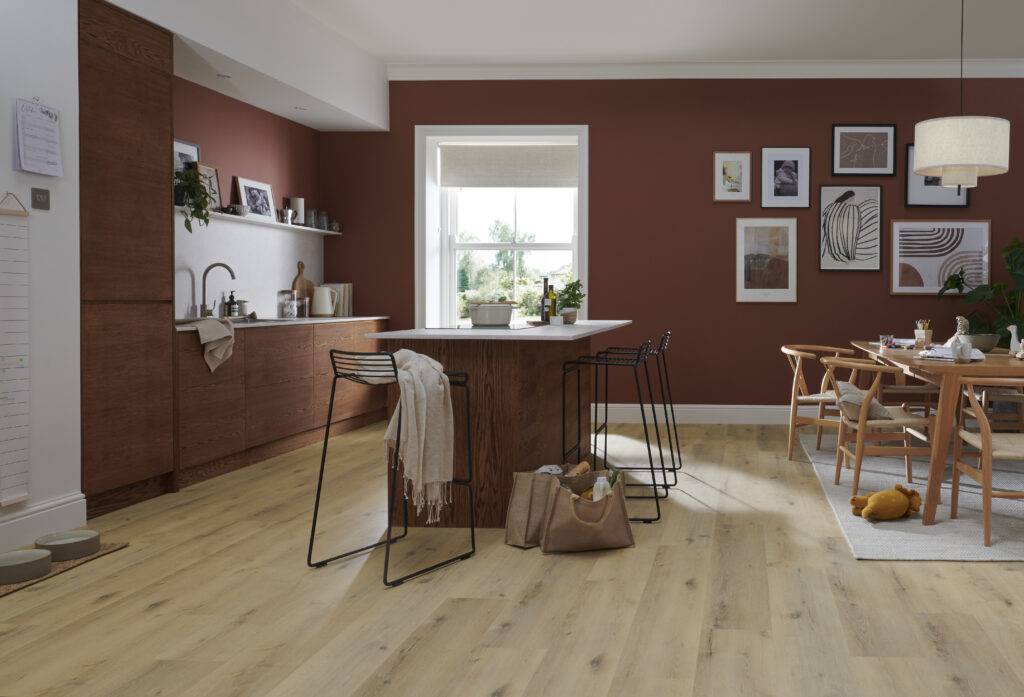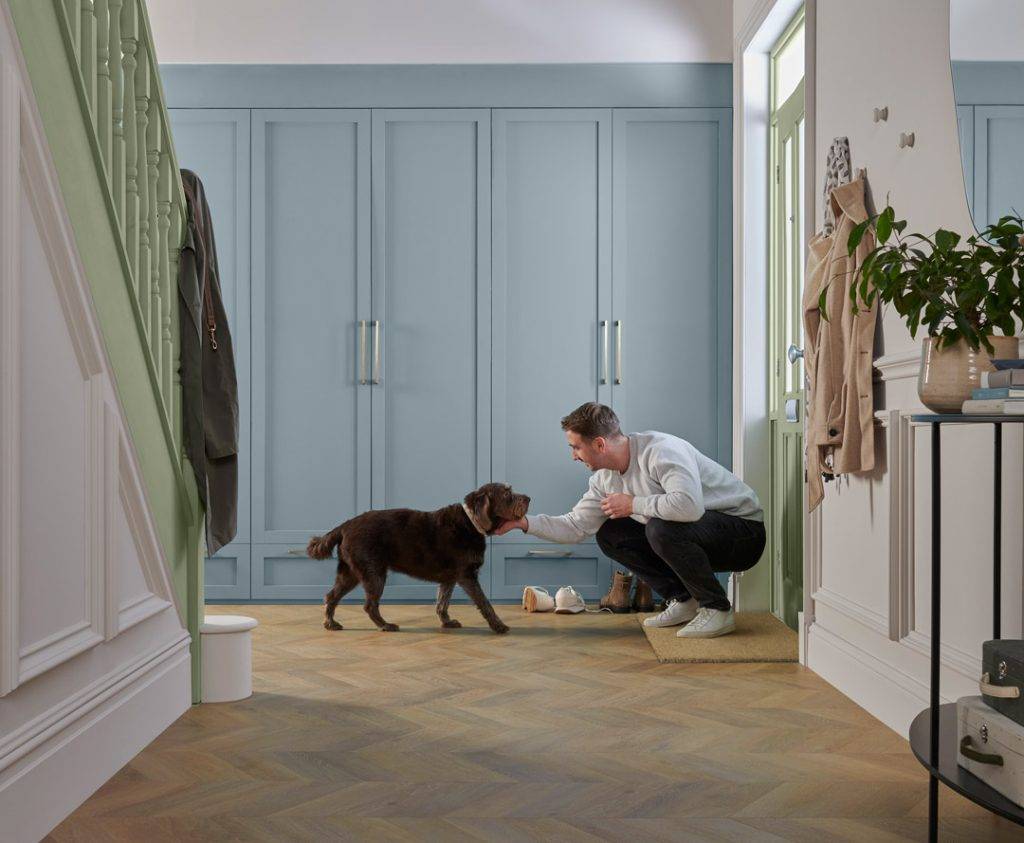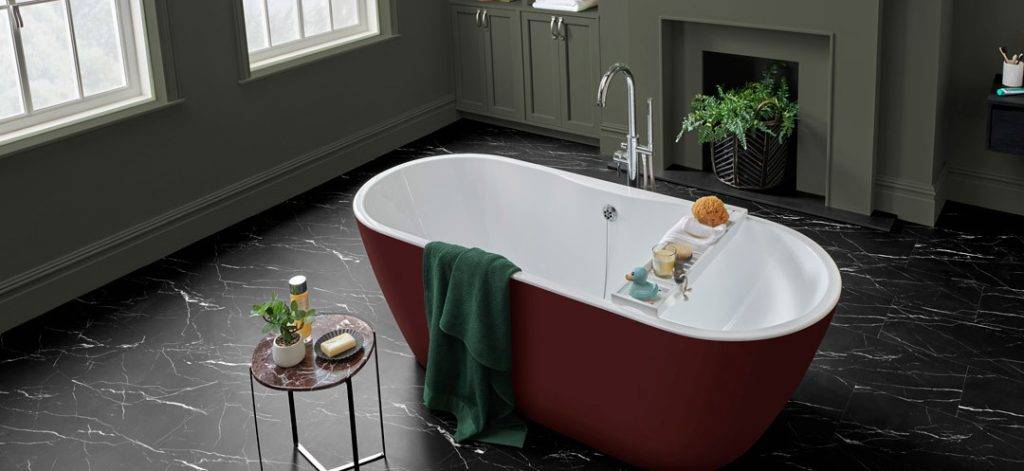Building homes from the floor up
Up to 3 FREE Samples
Building homes from the floor up
Up to 3 FREE Samples
Home / Stone Tile & Effect Flooring
Tile and stone effect LVT flooring opens up a wide range of stylish possibilities for your home. This style of flooring is waterproof, making it ideal for rooms with high moisture – such as bathrooms, kitchens, utility rooms etc.
One of the benefits of tile and stone effect flooring is that the flooring provides you with a stylish tile look without the hard and cold tile feeling underfoot, instead, you have the warm, soft feeling of luxury vinyl tiles.
This flooring has high durability, is long-lasting, has a lifetime domestic warranty, and is easy to maintain. If you want the look without the drawbacks, the key features of our tile and stone effect LVT could be the perfect option for you to make your home look sleek and stylish.
Luvanto’s flooring comes in commercial grade, meaning our flooring has the hard wearing thickness that you would find in areas that have moderate foot traffic, such as large shop floors, ensuring your flooring is extremely durable. LVT, in general, is a fantastic flooring that works in nearly every room, whether that be your hallways, your bathroom, etc.
Slip-resistant and easy to clean, this style of luxury vinyl flooring will bring out the classic look of natural stone in your home. Additional benefits include being compatible with underfloor heating, as well as being an easy installation job, and much more. Check our FAQs to find out more.
Filter By:
Colour
Room Suitability
Plank Suitability
Species
Suggested Flooring
Whether you’re seeking the timeless allure of hardwood or the sleek aesthetic of stone, our diverse range of LVT flooring suggestions promises to elevate your interior with unmatched charm and resilience. Experience the perfect harmony of beauty and practicality as you explore our innovative selection, curated to inspire and transform your home.
Clay Earth
Midnight Olive
Coastal Cottage




Trends come and go but a Luvanto floor is forever.
Keep your interiors looking show-home worthy with our colour and trend inspiration. As experts in colour forecasting and pairings, we match the latest trends and colours with each of our flooring shades so you can stay tickled pink with your décor all year round.
Our customers rate us Excellent
4.7/5 on verified customer reviews
Related Articles
Dive deeper into the world of luxury vinyl tile (LVT) flooring with our curated selection of articles, offering comprehensive insights and expert guidance on this versatile flooring solution. Whether you’re considering LVT for your next renovation project or simply seeking to expand your knowledge, our collection of articles serves as a valuable companion on your journey to achieving beautiful, long-lasting floors.
The Natural LVT flooring trend: Bring the Outdoors in
Crafting Industrial Style: Decorating with Stone Effect LVT Flooring from Luvanto
How to Style Dark Flooring
How to Style Herringbone Flooring
Understanding LVT Specifications and Technical Details: Your Guide to a Perfect Floor
Waterproof LVT for High-Moisture Bathrooms
Frequently Asked Questions
There are a great deal of advantages that tile effect luxury vinyl tiles have over true tiles.
Advanced photographic layers allow your luxury vinyl tiles to take on high-resolution imagery that pops out at you. The range of available patterns and colours is endless, unlike true tiles.
Natural tiles sometimes come with natural imperfections within the patterns that make it look less impressive than the consistent patterns that LVT flooring offers.
Our LVT flooring can come with realistic textures that are true to the tiles that they are mimicking, however, unlike the hard and cold feeling underfoot – you have a soft, springy and warm flooring.
Grout lines may look pretty, but in real porcelain tiles, they can collect a lot of dirt and be tricky to clean. This isn’t the case with LVT flooring.
Stone effect Vinyl flooring has some distinct advantages over true stone.
Stone Effect Luxury Vinyl tiles, in open spaces, can transition seamlessly and smoothly into other designs you may have on your property – such as wood, marble, slate or other styles of flooring.
True stone has a problem of discolouration or staining when coming into contact with liquid. However, stone LVT does not have any such issue. Stone effect LVT flooring is highly moisture and stain-resistant.
Another problem that true stone has that stone effect LVT does not, is how damage-prone it is. Chipping, fading, etc can occur through everyday use. That is not the case with LVT which is much more hardy and comes with a lifetime domestic warranty.
The stone effect vinyl flooring options we have at Luvanto are of the following:
Slate Effect LVT
Marble Effect LVT
Granite Effect LVT
Pebble and Mosaic Effect LVT
Terrazzo Effect LVT
Concrete and Polished Stone Effect LVT
Note that each of these types of floorings come in different shades and patterns.
Flooring
Inspiration
Where To Buy
Help And Support
Copyright © 2024 Luvanto - QA Flooring Solutions Ltd. All Rights Reserved.
QA Flooring Solutions Ltd is a company registered in England
Registered Office: Unit 2 Hurricane Drive, Speke, Liverpool, L24 8RL
Company Registration Number: 07870268 | VAT Number: 852026449
| Cookie | Duration | Description |
|---|---|---|
| cookielawinfo-checkbox-analytics | 11 months | This cookie is set by GDPR Cookie Consent plugin. The cookie is used to store the user consent for the cookies in the category "Analytics". |
| cookielawinfo-checkbox-functional | 11 months | The cookie is set by GDPR cookie consent to record the user consent for the cookies in the category "Functional". |
| cookielawinfo-checkbox-necessary | 11 months | This cookie is set by GDPR Cookie Consent plugin. The cookies is used to store the user consent for the cookies in the category "Necessary". |
| cookielawinfo-checkbox-others | 11 months | This cookie is set by GDPR Cookie Consent plugin. The cookie is used to store the user consent for the cookies in the category "Other. |
| cookielawinfo-checkbox-performance | 11 months | This cookie is set by GDPR Cookie Consent plugin. The cookie is used to store the user consent for the cookies in the category "Performance". |
| viewed_cookie_policy | 11 months | The cookie is set by the GDPR Cookie Consent plugin and is used to store whether or not user has consented to the use of cookies. It does not store any personal data. |
Building homes from the floor up
Up to 3 FREE Samples